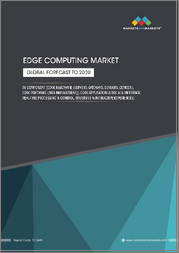
|
시장보고서
상품코드
1740737
세계의 엣지 AI 시장 : 컴포넌트, 용도, 최종사용자 산업, 지역별 기회 및 예측(2018-2032년)Global Edge AI Market Assessment, By Component, By Application, By End-user Industry, By Region, Opportunities and Forecast, 2018-2032F |
||||||
세계 엣지 AI 시장 규모는 2025년부터 2032년까지 예측 기간 동안 16.46%의 연평균 복합 성장률(CAGR)로 2024년 191억 2,000만 달러에서 2032년에는 647억 달러로 성장할 것으로 예측됩니다.
세계 엣지 AI 시장은 실시간 데이터 처리, 지연 감소, 지능형 의사결정에 대한 수요 증가로 인해 급성장하고 있으며, 5G, IoT, AI 기술의 발전으로 인해 엣지 AI는 차세대 디지털 인프라를 지원하는 핵심 기술로 자리매김하고 있습니다.
이 시장은 빠르게 진화하고 있으며, 모든 산업의 기업들은 데이터가 생성되는 곳에서 더 빠르고 스마트하며 안전한 처리를 원하고 있습니다. 기존 클라우드 기반 AI와 달리 엣지 AI는 계산 처리를 카메라, 센서, 스마트폰, 공장 내 로봇과 같은 디바이스 측으로 옮겨 지연 없는 실시간 의사결정을 가능하게 합니다. 특히, 조금의 지연도 허용되지 않는 자율주행 시스템, 산업기계 예지보전, 의료분야의 AI 진단, 스마트시티의 감시 시스템 등의 용도에서는 이러한 진화가 필수적입니다.
IoT 기기의 급증과 더불어 저전력 프로세서의 발전과 5G 연결의 보급은 엣지 AI의 대규모 채택을 위한 기반을 마련하고 있습니다. 예를 들어, 2025년 3월 IBM과 엔비디아는 제휴를 맺고 엔비디아의 AI 및 데이터 플랫폼 기술을 IBM의 왓슨엑스(watsonx) AI 및 데이터 플랫폼에 통합한다고 발표했습니다. 이번 제휴는 AI 도입을 촉진하고 IBM의 AI 추론, 훈련 및 엔터프라이즈 AI 기능을 강화하는 것을 목표로 합니다. 또한, 엣지 AI는 데이터 필터링과 현장 분석을 통해 운영 효율성을 크게 향상시킬 수 있습니다. 이를 통해 스토리지 비용을 절감하고, 행동에 이르는 시간을 단축할 수 있습니다. 엣지 컴퓨팅과 AI의 융합은 IT 인프라를 변화시킬 뿐만 아니라, 데이터 소비, 분석, 활용 방식 자체를 혁신하고 있습니다.
세계의 엣지 AI(Edge AI) 시장을 조사했으며, 시장 정의와 개요, 시장 규모 동향과 예측, 각종 부문별 상세 분석, 산업 구조, 시장 성장 촉진요인 분석, 경쟁 구도, 주요 기업 개요 등의 정보를 전해드립니다.
목차
제1장 프로젝트의 범위와 정의
제2장 조사 방법
제3장 미국 관세의 영향
제4장 주요 요약
제5장 고객의 소리
- 응답자 인구통계
- 브랜드 인지도
- 구입 결정시에 고려되는 요소
- 구입 후에 직면하는 과제
제6장 세계의 엣지 AI 시장 전망
- 시장 규모 분석, 예측
- 시장 점유율 분석, 예측
- 컴포넌트별
- 하드웨어
- 소프트웨어
- 서비스
- 용도별
- 비디오 감시
- 원격 모니터링
- 예지보전
- 기타
- 최종사용자 산업별
- 은행, 금융서비스 및 보험(BFSI)
- 헬스케어
- IT 및 통신
- 제조
- 소매
- 기타
- 지역별
- 북미
- 유럽
- 아시아태평양
- 남미
- 중동 및 아프리카
- 기업 점유율 분석(주요 5개사 및 기타)
- 컴포넌트별
- 시장 맵 분석
제7장 북미의 엣지 AI 시장 전망
- 시장 규모 분석, 예측
- 시장 점유율 분석, 예측
- 국가별 시장 평가
- 캐나다
- 멕시코
제8장 유럽의 엣지 AI 시장 전망
- 독일
- 프랑스
- 이탈리아
- 영국
- 러시아
- 네덜란드
- 스페인
- 튀르키예
- 폴란드
제9장 아시아태평양의 엣지 AI 시장 전망
- 인도
- 중국
- 일본
- 호주
- 베트남
- 한국
- 인도네시아
- 필리핀
제10장 남미의 엣지 AI 시장 전망
- 브라질
- 아르헨티나
제11장 중동 및 아프리카의 엣지 AI 시장 전망
- 사우디아라비아
- 아랍에미리트(UAE)
- 남아프리카공화국
제12장 Porter의 Five Forces 분석
제13장 PESTLE 분석
제14장 시장 역학
- 시장 성장 촉진요인
- 시장이 해결해야 할 과제
제15장 시장 동향 및 전개
제16장 사례 연구
제17장 경쟁 구도
- 주요 5개사의 경쟁 매트릭스
- 주요 5개사의 SWOT 분석
- 주요 10개사 상황
- Amazon Web Services, Inc.
- Intel Corporation
- Dell Inc.
- Google LLC
- Huawei Technologies Co., Ltd.
- ADLINK Technology Inc.
- Gorilla Technology Inc.
- Microsoft Corporation
- Nutanix, Inc.
- IBM Corporation
제18장 전략적 제안
제19장 회사 소개 및 면책조항
LSH 25.06.17Global edge AI market is projected to witness a CAGR of 16.46% during the forecast period 2025-2032, growing from USD 19.12 billion in 2024 to USD 64.70 billion in 2032. The global edge AI market is experiencing significant growth, fueled by rising demand for real-time data processing, reduced latency, and intelligent decision-making. Developments in 5G, IoT, and AI technologies are further accelerating adoption across industries, positioning edge AI as a key enabler of next-generation digital infrastructure.
The global edge AI market is evolving at a rapid rate, as businesses across all industries are looking for faster, smarter, and safer processing of data where the data is being generated. Unlike traditional cloud-based AI, edge AI moves computation to the device, whether that's a camera, sensor, smartphone, or factory robot, enabling real-time decision-making with no latency. This evolution becomes paramount in applications where every millisecond matters, i.e., autonomous vehicle systems, industrial predictive maintenance, AI-powered diagnostics in healthcare, and intelligent smart city surveillance.
The increased advent of Internet of Things (IoT) devices, coupled with the evolution of low-power processors and 5G connectivity, is setting the stage for mass edge AI adoption. For instance, in March 2025, IBM Corporation and NVIDIA Corporation partnered to integrate NVIDIA's AI and data platform technologies into IBM's watsonx AI and data platform. The collaboration is expected to drive the adoption of AI and advance IBM's AI inferencing, training, and enterprise AI capabilities. Further, edge AI brings considerable operational efficiency through data filtering and local analysis of material data, which decreases storage expense and enhances time-to-action. The intersection of edge computing and AI is not only transforming IT infrastructure but is also revolutionizing the way data is consumed, analyzed, and acted upon.
Advancements in AI and Machine Learning Drive the Global Edge AI Market
Global edge AI market is progressively growing with the ongoing evolution of artificial intelligence (AI) and machine learning (ML) technologies. With these, edge devices such as smartphones, cameras, industrial equipment, and driverless cars are being enabled to compute locally without reliance on centralized cloud infrastructure. This reduces latency, conserves bandwidth, and accelerates decision-making time.
Edge AI combines AI and edge computing, taking intelligence closer to where the data is being created. Edge AI supports real-time analytics, even in weakly connected rural regions, the most beneficial for industrial use cases such as manufacturing, agriculture, healthcare, and retail. For instance, in March 2025, Ambiq Micro released the Apollo330 Plus SoC series, providing ultra-low-power AI computing for edge healthcare devices with the Arm Cortex-M55 processor integrated with AI acceleration. This example reflects the growth of the global edge AI market, demonstrating how revolutionary hardware innovation is bringing real-time AI to the device side and affordably.
Expansion of Smart City Initiatives Surge Global Edge AI Adoption
The increasing emergence of smart cities around the world is fueling Edge AI solutions. Smart cities need real-time monitoring, optimized traffic management, smart energy consumption, public safety monitoring, and responsive infrastructure management. Governments and municipalities are deploying sensors, cameras, and IoT devices that produce enormous amounts of data. Processing data at the edge, closer to the source, is critical to reduce latency and ensure real-time responsiveness. Edge AI allows devices to conduct real-time analytics and make automated decisions without relying on a central data center.
For instance, in November 2024, Smartmotion made a major boost to its traffic management system by making integration with off-the-shelf cameras possible in a seamless manner. This innovation enables cities to use installed camera infrastructure, lowering the requirement for dedicated hardware and enabling real-time analysis of traffic data to manage signal timings and enhance urban mobility. With ongoing investments in urban digital transformation and sustainability by countries, edge AI technologies are likely to become core infrastructure for city planning and development.
Software Segment Holds the Largest Global Edge AI Market Share
The software segment is escalating as a key segment in the growth of the global edge AI market. As there is an increasing demand for intelligent and autonomous decision-making at the edge, robust software frameworks and AI models are needed with effective deployment, management, and optimization of applications based at the edge. Edge AI software is essential to build machine learning models, manage data pipelines, offer real-time analytics, and enable devices to seamlessly communicate between devices and systems. Advances in AI model compression, containerization, and neural network optimization now enable complex algorithms to run efficiently on compact edge devices without sacrificing performance. In addition, software platforms are now delivered with developer-friendly UIs, pre-trained models, and cross-platform support, thereby reducing development time and speeding up deployment of AI-powered edge solutions.
For instance, in 2024, NVIDIA Corporation launched its JetPack SDK, a platform software that speeds up computing for edge AI applications on Jetson systems. SDK facilitates training, inference, and real-time deployment of AI models at the edge to enable developers to easily create and scale AI-based applications. As organizations continue to invest in decentralized intelligence, the software component will continue to be an underlying driver for edge AI adoption in industries such as healthcare, automotive, manufacturing, and smart cities.
North America Dominates the Global Edge AI Market
North America is the leading region in the global edge AI market, driven by a robust technological base, high usage of advanced technologies, and intensive investment in artificial intelligence and edge computing technologies. The region further benefits from a concentration of industry-leading tech firms and robust research and development initiatives.
For instance, in March 2025, Latent AI and Carahsoft Technology Corporation announced a partnership to drive the use of edge AI in the U.S. public sector at faster rates. Carahsoft is anticipated to resell Latent AI's Efficient Inference Platform software as well as ruggedized mobile solutions to government agencies through its reseller base and contracts. The developments illustrate the region's emphasis on driving edge AI technologies in various sectors such as healthcare, automotive, and manufacturing. With continued backing from government policies and a thriving tech entrepreneur ecosystem, North America is most likely to remain at the top of the global edge AI market.
Impact of U.S. Tariffs on Global Edge AI Market
U.S. tariffs on AI-related hardware and components have mainly impacted the global edge AI market. The levies, particularly the Chinese import levies, have increased the prices of primary components such as AI accelerator chips and embedded processors. This is inducing elevated production costs and supply chain interference for businesses. Therefore, many companies are spreading their manufacturing bases, moving production to countries such as Southeast Asia and Mexico to mitigate risks related to tariffs. In addition, emphasis is growing on software optimization techniques such as model quantization and pruning to advance performance using less expensive hardware.
Key Players Landscape and Outlook
The global Edge AI market has been framed as a diversified market with a mix of incumbent tech giants and new entrants. Diversity generates intense competition, promoting relentless innovation and strategic collaborations to further edge computerization in various industries. The leading players are making heavy investments in research and development to create complex AI chips, software platforms, and integrated solutions tailored for edge applications.
Aside from partnerships, significant investments are shaping the trajectory of the market. In May 2025, AMD and NVIDIA signed multi-billion-dollar AI partnerships with Saudi Arabia, which is investing around USD 10 billion under the Humain, the Saudi public investment fund's AI arm. These strategic collaborations are transitioning Saudi Arabia's efforts to a global AI center, indicating the shift of AI chip demand towards the Middle East.
Traditional players provide scale resources and expertise, while startups provide flexibility and domain-specific innovations. This critical environment fosters ongoing advancement ensuring clients are exposed to a broad spectrum of solutions tailored to exact requirements. Furthermore, the Edge AI market is anticipated to grow steadily, driven by ongoing technological evolution, strategic partnerships, and increasing demand from different industries for real-time processing of data.
Table of Contents
1. Project Scope and Definitions
2. Research Methodology
3. Impact of U.S. Tariffs
4. Executive Summary
5. Voice of Customers
- 5.1. Respondent Demographics
- 5.2. Brand Awareness
- 5.3. Factors Considered in Purchase Decisions
- 5.4. Challenges Faced Post Purchase
6. Global Edge AI Market Outlook, 2018-2032F
- 6.1. Market Size Analysis & Forecast
- 6.1.1. By Value
- 6.2. Market Share Analysis & Forecast
- 6.2.1. By Component
- 6.2.1.1. Hardware
- 6.2.1.2. Software
- 6.2.1.3. Service
- 6.2.2. By Application
- 6.2.2.1. Video Surveillance
- 6.2.2.2. Remote Monitoring
- 6.2.2.3. Predictive Maintenance
- 6.2.2.4. Others
- 6.2.3. By End-user Industry
- 6.2.3.1. Banking, Financial Services, and Insurance (BFSI)
- 6.2.3.2. Healthcare
- 6.2.3.3. IT and Telecom
- 6.2.3.4. Manufacturing
- 6.2.3.5. Retail
- 6.2.3.6. Others
- 6.2.4. By Region
- 6.2.4.1. North America
- 6.2.4.2. Europe
- 6.2.4.3. Asia-Pacific
- 6.2.4.4. South America
- 6.2.4.5. Middle East and Africa
- 6.2.5. By Company Market Share Analysis (Top 5 Companies and Others - By Value, 2024)
- 6.2.1. By Component
- 6.3. Market Map Analysis, 2024
- 6.3.1. By Component
- 6.3.2. By Application
- 6.3.3. By End-user Industry
- 6.3.4. By Region
7. North America Edge AI Market Outlook, 2018-2032F
- 7.1. Market Size Analysis & Forecast
- 7.1.1. By Value
- 7.2. Market Share Analysis & Forecast
- 7.2.1. By Component
- 7.2.1.1. Hardware
- 7.2.1.2. Software
- 7.2.1.3. Service
- 7.2.2. By Application
- 7.2.2.1. Video Surveillance
- 7.2.2.2. Remote Monitoring
- 7.2.2.3. Predictive Maintenance
- 7.2.2.4. Others
- 7.2.3. By End-user Industry
- 7.2.3.1. Banking, Financial Services, and Insurance (BFSI)
- 7.2.3.2. Healthcare
- 7.2.3.3. IT and Telecom
- 7.2.3.4. Manufacturing
- 7.2.3.5. Retail
- 7.2.3.6. Others
- 7.2.4. By Country
- 7.2.4.1. United States
- 7.2.4.2. Canada
- 7.2.4.3. Mexico
- 7.2.1. By Component
- 7.3. Country Market Assessment
- 7.3.1. United States Edge AI Market Outlook, 2018-2032F
- 7.3.1.1. Market Size Analysis & Forecast
- 7.3.1.1.1. By Value
- 7.3.1.2. Market Share Analysis & Forecast
- 7.3.1.2.1. By Component
- 7.3.1.2.1.1. Hardware
- 7.3.1.2.1.2. Software
- 7.3.1.2.1.3. Service
- 7.3.1.2.2. By Application
- 7.3.1.2.2.1. Video Surveillance
- 7.3.1.2.2.2. Remote Monitoring
- 7.3.1.2.2.3. Predictive Maintenance
- 7.3.1.2.2.4. Others
- 7.3.1.2.3. By End-user Industry
- 7.3.1.2.3.1. Banking, Financial Services, and Insurance (BFSI)
- 7.3.1.2.3.2. Healthcare
- 7.3.1.2.3.3. IT and Telecom
- 7.3.1.2.3.4. Manufacturing
- 7.3.1.2.3.5. Retail
- 7.3.1.2.3.6. Others
- 7.3.1.2.1. By Component
- 7.3.1.1. Market Size Analysis & Forecast
- 7.3.1. United States Edge AI Market Outlook, 2018-2032F
All segments will be provided for all regions and countries covered
8. Europe Edge AI Market Outlook, 2018-2032F
- 8.1. Germany
- 8.2. France
- 8.3. Italy
- 8.4. United Kingdom
- 8.5. Russia
- 8.6. Netherlands
- 8.7. Spain
- 8.8. Turkey
- 8.9. Poland
9. Asia-Pacific Edge AI Market Outlook, 2018-2032F
- 9.1. India
- 9.2. China
- 9.3. Japan
- 9.4. Australia
- 9.5. Vietnam
- 9.6. South Korea
- 9.7. Indonesia
- 9.8. Philippines
10. South America Edge AI Market Outlook, 2018-2032F
- 10.1. Brazil
- 10.2. Argentina
11. Middle East and Africa Edge AI Market Outlook, 2018-2032F
- 11.1. Saudi Arabia
- 11.2. UAE
- 11.3. South Africa
12. Porter's Five Forces Analysis
13. PESTLE Analysis
14. Market Dynamics
- 14.1. Market Drivers
- 14.2. Market Challenges
15. Market Trends and Developments
16. Case Studies
17. Competitive Landscape
- 17.1. Competition Matrix of Top 5 Market Leaders
- 17.2. SWOT Analysis for Top 5 Players
- 17.3. Key Players Landscape for Top 10 Market Players
- 17.3.1. Amazon Web Services, Inc.
- 17.3.1.1. Company Details
- 17.3.1.2. Key Management Personnel
- 17.3.1.3. Key Products/Services Offered
- 17.3.1.4. Key Financials (As Reported)
- 17.3.1.5. Key Market Focus and Geographical Presence
- 17.3.1.6. Recent Developments/Collaborations/Partnerships/Mergers and Acquisition
- 17.3.2. Intel Corporation
- 17.3.3. Dell Inc.
- 17.3.4. Google LLC
- 17.3.5. Huawei Technologies Co., Ltd.
- 17.3.6. ADLINK Technology Inc.
- 17.3.7. Gorilla Technology Inc.
- 17.3.8. Microsoft Corporation
- 17.3.9. Nutanix, Inc.
- 17.3.10. IBM Corporation
- 17.3.1. Amazon Web Services, Inc.
Companies mentioned above DO NOT hold any order as per market share and can be changed as per information available during research work.



















